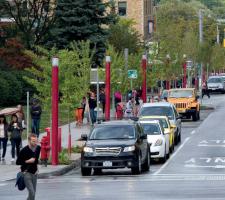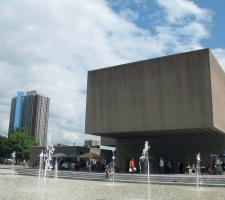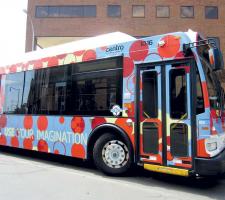
A connective corridor in Syracuse, New York State, could be a model for other post-industrial cities, as David Crawford discovers.
The aim of the city of Syracuse’ 5.6km-long Connective Corridor in Onandaga County in upstate New York is to create a model ‘complete street’ for use in wider regeneration schemes. Key transport-sector components are traffic calming, high-quality transit with accessible passenger information, plus walkability and bike-friendliness.
The collaborative, US$45million project, being funded by a combination of US federal and New York state grants and private donations, sets out to give a new look to one of the US’ swathe of post-industrial cities. The funders hope that it will prove to be an inspiration to others.
Supported by New York State and the US Department of Transportation, the scheme is under the overall administration of the latter’s FHWA. It is being managed by Syracuse University through its Office of Community Engagement and Economic Development.
Core routes are already benefitting from streetscape reconstruction involving traffic speed slowing and more closely-spaced pedestrian crossings with audible count-down timers. Infrastructural work is due for completion in 2015.
A central communications element of the project is the creation of an attractive and efficient transit link between the Syracuse University campus, downtown businesses and the city’s growing array of arts and leisure offers. This takes the form of the Connective Corridor Bus, a free loop service funded by the University, running between its campus and the city’s new central transit hub.
This was opened in September 2012 by local operator Centro (the Central New York Regional Transportation Authority). The agency runs urban and suburban fixed routes; paratransit that meets Americans with Disabilities Act standards; rural services in Onondaga and three neighbouring counties, Cayuga, Oneida and Oswego; and parking in Syracuse.
Relocation of the hub has involved a wholesale reconfiguration of the previous traffic signal array on surrounding streets to allow buses seamlessly to enter general traffic flows. A dedicated signal phase operates only when buses are exiting.
The corridor has also served as the pilot site for Centro’s plan to introduce a GPS-based Bus Tracker real-time passenger information system. Presented in an in-car navigation style, this enables users to call up a street layout on their smartphones and to follow the bus while it is on the move.
Passengers can also sign up to an E-Alert service, available by text or email, to access current information on changes to schedules or major disruptions, for example, those caused by weather conditions.
An interactive map of the corridor identifies locations of interest and give bus schedules at the most convenient of the distinctively designed stops.
Centro vice-president for business development and corporate communications Steven Koegel told ITS International:
“Passengers love the technology. Not only can you see your bus on a map, but you can have alerts sent to warn you it when it’s approaching.
“It’s very reassuring to the user. On the bus, stops are automatically announced, which is a great asset for the sight-impaired”.
The information automatically updates every 30 seconds and the developer of the system is locally-based
Following its successful trial on the corridor, Centro has now expanded the system to its bus networks in four other cities in central New York State – Utica, Auburn, Oswego and Rome. The final and largest phase of the rollout will cover the whole of Syracuse by the end of 2015.
Currently the agency has an official system-wide Bus Tracker app, and another one designed exclusively for use on the Connective Corridor loop and it expects commercial developers to want to produce their own versions. Says Koegel: “We’ve already had many requests for access to our Bus Tracker API information.”
Centro has also updated its existing Trip Planner, which allows passengers across the central region of New York State to create, view, and print bus information and customised travel itineraries within its service areas. It enables users to click on, and enter relevant origin and destination information.
They can input their home or business address, an intersection or a landmark. An enhanced address database incorporates an auto-fill feature for most city locations.
In a parallel service, Centro offers a detour page on its website, updating on route diversions. It is currently developing an app that will bring together in a single offer all its passenger-oriented products - Bus Tracker, detour information and its Trip Planner – and is expected to be available by the end of the year. Corridor ridership is now running at 200,000 a year.
Recent phases of the overall corridor programme have included the rollout of a range of purpose-designed travel aids, with the emphasis on the needs of visitors and walkers. These include an array of 36 red pedestrian direction signs showing how much time it will take to walk from one location to another; and six interactive, electronic kiosks at outdoor sites in downtown Syracuse.
June 2015 saw the introduction of another initiative, in the first of a planned network of 11 tourist assistance portals destined for installation at visitor locations including the Everson Museum, the first devoted to collecting American art, and the Milton J Rubinstein Museum of Science and Technology.
The interactive touchscreen kiosks work in the same way as websites to give travel, directional, event and local business information, which users can then have sent direct to their mobile phones and email addresses. Partly the aim is environmental, to reduce the paper waste of brochures and leaflets.
Georgia-based BlueFocus Media supplied the system and has installed similar arrays in Newport, Rhode Island and Newark, New Jersey.
However, there have been problems. These include severe criticism after vandals smashed the US$1,000 apiece (plus labour) lights in the waist-high ‘bollards’ that mark a cycle path along University Avenue. The bollards have now been raised.
Project results to date suggest, among other positive trends, that cyclists are now finding University Avenue much friendlier to use because of its new bike lane. This has added weight to plans for a wide-scale interconnected bicycling network aimed at turning Syracuse into a ‘cycle city’, drawing on experience from as far away as Denmark.
Proposed elements include bicycle-friendly traffic signals with phased light symbols that allow time for cyclists to move apart from motor vehicles at intersections. Cited advantages, despite the high costs of installation and signal coordination, include the improved predictability of overall vehicle movements, for the benefit of traffic management, and reduced conflicts.
Says Syracuse University’s Community Engagement and Economic Development director, Linda Hartsock: “Great Canadian cities—such as Toronto, Ottawa and Montreal—have vibrant, four-season bike communities. These kinds of urban amenity are part of creating places that attract and retain our best and brightest.”
Design and construction administration are in the hands of environmental planners and engineers Barton & Loguidice.
The project
Syracuse is the administrative centre of Onandaga County in New York State with a metro region population of some 750.000. It is the economic and educational hub of the Central New York region and the home of the annual 12-day Great New York State Fair, It has operated as a transport crossroads for two centuries, first for waterways, then railways, and more recently for road (it sits at the intersection of interstate highways I-81 and I-90) and air links (its airport is the largest in the region). I-81, running on a largely outworn viaduct, bisects the heart of the city but is an important commuter route and national and international trade route between the US South and the Canadian border.
There are advanced plans for its reconstruction, within a 'priority area' of street-level boulevards linked by cycle and pedestrian crossings with dedicated traffic signals. Syracuse University is a major US research institution with a student population of 12,500. Founded in 2005 by its School of Architecture, the interdisciplinary UPSTATE Center focuses on innovation in urban design. It aims to deploy planning and architecture to regenerate post-industrial cities such as Syracuse across the US rust belt that have experienced migrations of city-centre jobs and people to suburbs, with resulting empty properties depleting city budgets.














